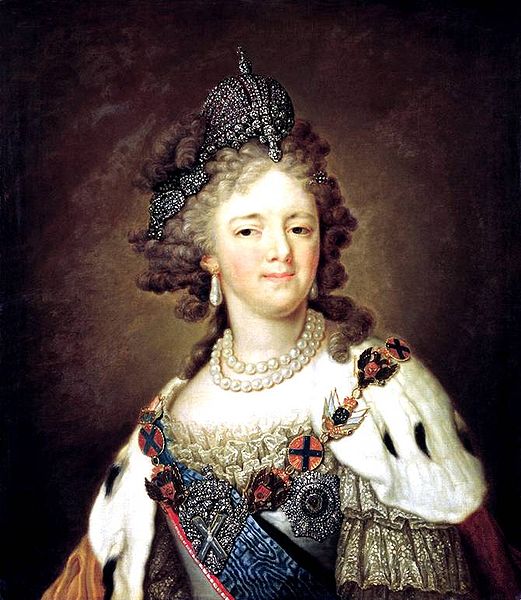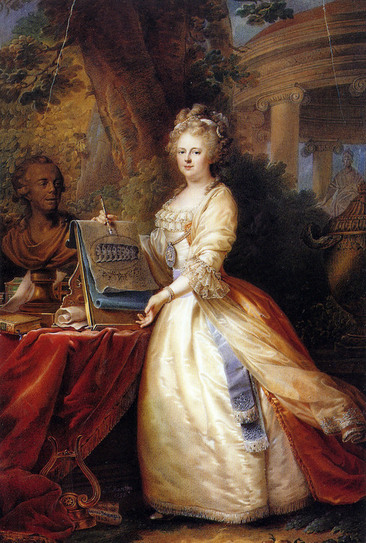<Back to Index>
- Mathematician Ivan Morton Niven, 1915
- Composer Georges Alexandre César Léopold Bizet, 1838
- Empress consort of All the Russias Maria Feodorovna (Sophie Dorothea of Württemberg), 1759
PAGE SPONSOR
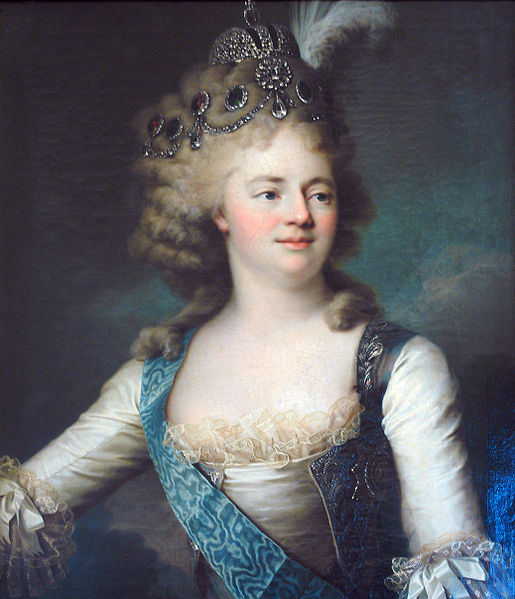
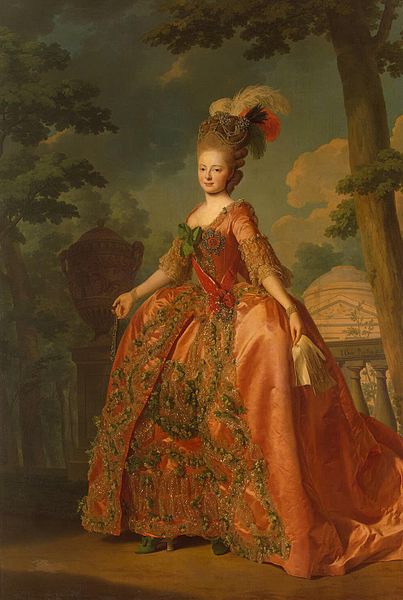
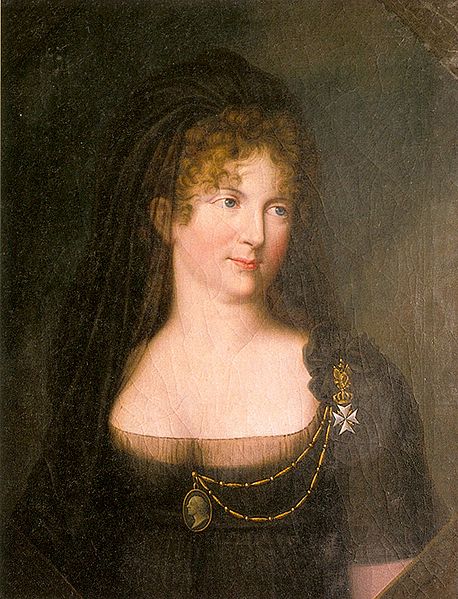
Maria Feodorovna (Russian: Мари́я Фёдоровна) (25 October 1759 – 5 November 1828) was the second wife of Tsar Paul I of Russia and mother of Tsar Alexander I and Tsar Nicholas I of Russia.
Maria Feodorovna was born in Stettin, Prussia, on 25 October 1759 as Duchess Sophie Marie Dorothea Auguste Louise of Württemberg. She was a daughter of Friedrich II Eugen, Duke of Württemberg and his wife Friederike Dorothea of Brandenburg - Schwedt. Named after her mother, Sophia Dorothea, as she was known in her family, was the eldest daughter of eight children, five boys and three girls. In 1769, when she was ten years old, her family took up residence in the ancestral castle at Montbéliard, then an exclave of the Duchy of Württemberg, today part of Franche - Comté. Her younger brother Alexander of Württemberg was born there. Montbéliard was the seat of the junior branch of the House of Württemberg to which she belonged, it was also a cultural center and many intellectual and political figures frequented her parents' palace. The family's summer residence was situated at Étupes.
Princess Sophie’s education was better than average in the culture oriented paternal home and she would love the arts all her life. By the age of sixteen, she spoke German, French, Italian and Latin. When she turned seventeen, Sophia Dorothea was tall, buxom and rosy cheeked with a sunny disposition. She was strong and tender, thoughtful and naive. She had been brought up according to French fashion and refinements, as was the custom of that era, but with German bourgeois simplicity. Family virtues were to be valued above all.
In 1773, Sophie Dorothea was among the group of German Princesses considered as possible wives of the heir to the Russian throne, the future Tsar Paul I. However, Sophie of Württemberg was not yet fourteen years old at that time, and Wilhelmina Louisa of Hesse - Darmstadt a princess of a more appropriate age was chosen instead.
Sophie was engaged to Prince Louis of Hesse, brother of Paul’s first wife, but when the Russian heir to the throne became a widower in 1776, Frederick II of Prussia proposed Sophie as the ideal candidate to be Paul's second wife. Sophie's former fiancé, the Prince of Hesse - Darmstadt, received a monetary compensation when the engagement was broken. Sophie was seventeen years old and pleased with the prospect of being Empress of Russia. When her mother lamented the unfortunate destiny of some Russian sovereigns, she replied that her only concern was to make her way in her new country quickly and successfully.
The Russian Empress, Catherine II,
was delighted with the idea. The princess of Württemberg shared
with her not only a similar education but also the same original name
and place of birth. Frederick II arranged the marriage and Sophie was
summoned to Berlin, where Paul joined her. They met for the first time at a state dinner
given in honor of his arrival in Berlin. Sophie was eager to please,
having learned that Paul's tastes were serious: she talked geometry with
him during their first interview. Next day she wrote a glowing letter
to a friend in which she declared that she was "madly in love". Paul
was as happy with the young princess as she was with him. "I found my
intended to be such as I could have dreamed of," Paul wrote to his
mother, "She is tall, shapely, intelligent, quick - witted, and not at
all shy." Sophie’s first impressions were no less enthusiastic. "I am more than content," she wrote. "Never,
dear friend, could I be happier. The Grand Duke could not be more kind.
I pride myself on the fact that my dear bridegroom loves me a great
deal, and this makes me very, very fortunate." By early fall, she had
fallen deeply in love with her future husband. "I cannot go to bed, my
dear and adored Prince, without telling you once again that I love and
adore you madly," she wrote to Paul. Soon after arriving at St Petersburg that September, she converted to the Orthodox Church,
took the title of Grand Duchess of Russia and traded the name Sophie
Dorothea for Maria Feodorovna. The wedding took place on 26 September 1776. Paul was of difficult character but Maria Feodorovna was completely satisfied with her fate. "My dear husband is a perfect angel and I love him to distraction" she
wrote to a friend. Maria Feodorovna never changed her feelings for
Paul, and despite everything that happened later, despite his difficult
and often tyrannical character, she truly loved him. Catherine
II, at least at the beginning, was enchanted with her daughter-in-law,
about whom she wrote to a friend: "I confess to you that I am
infatuated with this charming Princess, but literally infatuated. She
is precisely what one would have wished: the figure of a nymph, a lily
and rose complexion, the loveliest skin in the world, tall and well
built; she is grateful; sweetness, kindnesses and innocence are
reflected in her face." However,
the relationship between the two women quickly turned sour. Maria
naturally sided with her neglected husband in the acrimony between the
Empress and her son, and the Grand Duchess's good intention to ease the
difficult situation only aggravated the differences between them. In December of 1777, Maria gave birth to the first of her ten children, the future Tsar Alexander I.
Just three months later, Catherine took the new born away to raise him
on her terms without interference from the parents. When a second son
was born in April 1779, Catherine did the same thing. This caused
bitter animosity with Maria, as the parents were only allowed weekly
visits. For the next four years, the couple did not have any more
children. Deprived of rearing her eldest sons, Maria Feodorovna had to
occupy herself decorating the Palace of Pavlovsk,
Catherine's gift to celebrate the birth of her first grandson. Maria's
efforts would produce one of the most beautiful estates in all of
Russia. Maria Feodorovna was tall, fair, fresh, extremely shortsighted and inclined to be stout. Her
carriage was indisputably regal, and she loved the pomp and ceremony
associated with court life. She also had a taste for splendor and a
passionate interest in small court intrigues. Particularly tenacious of
her rank, she was prepared to spend the whole day from morning until
night in full dress without respite or fatigue, implacably imposing the
same burden on all her entourage, and was ruled by etiquette in the most intimate details of her domestic life. She loved order and regularity. Unlike the Romanovs,
she was frugal, a rare virtue in a princess of that time, but she came
from a large family that for a long time was only a minor branch of the
house of Württemberg. Her
even temper and her patience were instrumental in knowing how to deal
with a difficult husband and make a success of her marriage. Her
parsimony was such that as a new Grand Duchess, she did not hesitate to
take over the clothes of her husband's first wife and to dispute with
the lady's maids the very slippers of the defunct Natalia. Maria cultivated the arts with great enthusiasm, not disdaining even needlework. She
was skilled in watercolor, she also knew engraving, designed cameos,
and created objects of ivory and amber, which she often presented as
gifts. She was a gifted musician, and was a renowned specialist in
horticulture, with a lifelong passion for flowers and plants. At
Pavlovsk she gathered a literary circle in imitation of that of
Étupes, and she organized theatricals for her husband, who
delighted in that amusement. In addition to all this, she found time to
devote energies to the great charities and
educational institutions. She established the institute for the blind
in Saint Petersburg, and supported the career of the blind musician Charlotta Seuerling,
whose mother she saved from ruin. Serious and purposeful, she prided
herself in being more clever than her mother - in - law, never losing an
opportunity of contrasting her own impeccable virtue with her
mother - in - law's failings. She was equally watchful to attack
Catherine's favorites Potemkin and Mamonov. Clever,
talented, purposeful and energetic, Maria Feodorovna would make a
nearly perfect Imperial wife, and Paul for many years would be a model
husband deeply in love with the woman he married. Paul and Maria asked Catherine for permission to travel abroad to Western Europe. In September 1781, under the pseudonyms of "the Count and Countess Severny," the heir to the Russian throne and his wife set off on a journey that lasted fourteen months and took them to Poland, Austria, Italy, France, Belgium, Holland and Germany. Paris made a special impression on the couple. In Austria, Joseph II compared Maria Feodorovna with her husband, finding her superior. During
their visit to Italy, they proved to be much in love, surprising their
travelling companions, when Paul could not stop giving kisses in public
to his wife. On their way back to St. Petersburg, Maria went to
Württemberg to visit her parents. At the end of 1782, they
returned to Russia, and Maria devoted her attention to her Palace at
Pavlovsk, where she gave birth to Alexandra Pavlovna, the first of six daughters she would bear during the next twelve years.
To celebrate Alexandra's birth, Catherine II gave them the Palace of Gatchina, that would occupy Paul's attention until he was called to the throne. Catherine II let the parents raise their daughters. Maria
Feodorovna had ten children: four sons and six daughters. From then on
the Russian Imperial house, which until then consisted of only Paul,
would be a large family. The younger children were given up to the
parents. During
the long years of Catherine's reign, Maria and Paul were forced to live
in isolation in Gatchina with a tight income. They remained a devoted
couple. Maria moderated the extreme elements in her husband's
character, having a beneficial influence over him. She continued to
beautify Pavlovsk, and dedicated herself to charitable work among its
inhabitants. She was devoted to expand her modest literary salon and
ardently planned infrequent theatrical and musical evenings for her
family and friends. She herself was an adept player of the harpsichord and loved to read. She kept voluminous diaries that
recorded her life in detail. However, in keeping with her last wishes,
Nicholas I burned all these volumes after her death. Even most of the
letters she wrote have not survived since she usually requested that
they be burnt. The close relationship between Paul and Catherine Nelidova, one of Maria Feodorovna's ladies - in - waiting,
was cause of the first crack in their marriage. Paul's liaison, a
deeply intense but, according to him, only platonic attachment to
Nelidova, was particularly painful for Maria Feodorovna, as the other
woman had been her friend. Her relations with Nelidova became very
bitter for several years. Later, however, she began to accept Paul's
word that it was only a friendship, and eventually Maria not only
reconciled with the idea, but joined forces with Nelidova in an attempt
to moderate Paul's increasingly neurotic temperament. After
twenty years in the shadows, the death of Catherine II in 1796 allowed
Maria Feodorovna to have a prominent role as Empress consort. During
Catherine's lifetime, Maria had no chance of interfering in affairs of
state, as Paul himself was excluded, but after her husband's accession
to the throne, she took to politics, at first timidly, but increasingly
resolutely afterwards. Her
influence over her husband was great, and in general beneficial. Even
so, it is possible that she abused it in order to help her friends or
hurt her enemies. Maria had exceptional taste. The palaces of Gatchina, Tsarskoe Selo, the Winter Palace in St. Petersburg and The Hermitage were decorated and furnished under her personal guidance. She loved all the
arts and supported them generously. Her most important heritage to
Russia, however, was the establishment of the first schools for women,
as well as numerous charitable organizations in the empire. These
institutions existed until the Russian Revolution of 1917.
As Empress, she helped as much as possible her numerous poor relations,
some of whom, for example her brother, Alexander of Württemberg
(1771 – 1833), were invited to Russia. Although
Paul and his wife were not as close as they once had been, there
remained a good deal of warmth between them. Their relationship
suffered further in the last years of Paul's life. After Maria gave
birth to her tenth and last child in 1798, Paul became infatuated with
nineteen year old Anna Lopukhina,
and this time Paul assured his wife that his behavior was
irreproachable and that the relationship was of a paternal nature. Paul
was Emperor for exactly four years, four months and four days. He was
murdered on 12 March 1801. On
the night of her husband's assassination, Maria Feodorovna thought to
imitate the example of Catherine II and tried to proclaim herself
Empress on the grounds that she had been crowned with Paul. It took
Maria's son, Alexander I, several days to persuade her to relinquish
her reckless claim, for which she had no party to support her. For some
time afterward, whenever her son came to visit, the Dowager Empress
would place a casket between them containing the bloodstained
nightshirt that Paul was wearing on the day of the murder, as a silent
reproach. The strained relationship between mother and son improved
though, and thanks to the new Tsar, Maria Feodorovna, only forty-two
years old when she became a widow, kept the highest female position at
court. In public ceremonies, Maria often took the emperor’s arm, while
the Empress Elisabeth had
to walk behind. This custom of precedence of the Dowager Empress over
the wife of the reigning monarch was introduced with her and was unique
to the Russian court. It did cause resentment with Maria’s
daughter-in-law. Maria
not only had the highest female rank in the empire, but managed all the
charitable establishments, controlled the bank for loans and enjoyed a
considerable income. This substantial revenue made it possible for her
to live in grand style. Her apartments were furnished with richness and great taste. Perpetuating the tradition of Catherine II, she attended parades in military uniform, the cordon of an order across her breast. Her elegant, gay receptions, where she appeared sumptuously dressed, surrounded by ladies - in - waiting and chamberlains,
were in sharp contrast with the simple court life of Tsar Alexander I,
whose retiring ways and the withdrawn personality of his wife were no
match for the Dowager Empress' old splendor in the style of the time of
Catherine the Great. The
future of her daughters and the education of her three younger children
kept Maria’s attention occupied during the first years of her
widowhood. She was a good and loving mother, and despite the fact that
Catherine took over her two eldest children in their early years, Maria
Feodorovna managed to maintain close relationships with them, as with
all her children. They remained genuinely attached to her. Her son let her have total control over the future Nicholas I and his younger brother Grand Duke Michael. Maria Feodorovna tried in vain to surpass the education which Catherine
II had provided for her two eldest sons, but did not choose the best
teachers for the young ones. Once all her children were grown up, the
dowager tsarina maintained an avid correspondence with them, but being
of a cold temperament, could be cool and remote. The Dowager Empress' exalted position made her Palace at Pavlovsk a
mandatory place to visit for the great personages of St. Petersburg,
but her attempts at having more political influence over her son's
policies were not very successful. She vehemently opposed any approach
her son made to get to an agreement with Napoleon Bonaparte. In this, she maintained her haughty and categorical opinion. When the French Emperor offered to marry her youngest daughter, Anna Pavlovna, Maria strongly opposed the proposed marriage. Her court was the center of anti-Napoleon sentiment during the Napoleonic Wars and she was a bitter enemy of Bonaparte. Even
past fifty, she retained traces of her youthful freshness. Of a robust
constitution, she outlived five of her ten children, including her
eldest son and his wife Elisabeth Alexeievna, seeing the ascension to
the throne of her third son, Nicholas I, and was an influential figure
in the early education of her grandson, the future Alexander II. She died in Pavlovsk on 5 November 1828, at the age of sixty-nine. After
her death, Maria's memory was revered by her children and
grandchildren. Later Russian tsarinas looked up to her and used her as
a role model. Her Palace of Pavlovsk, in which she lived for so long
and left a big imprint, was maintained for her descendants as she left
it, almost as a family museum, in accordance with her instructions,
first by her younger son Michael and later by the Konstantinovich
branch of the family who inherited and kept it until the Russian
revolution.
